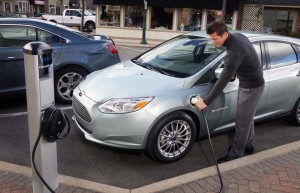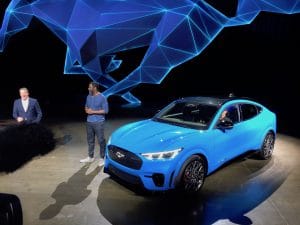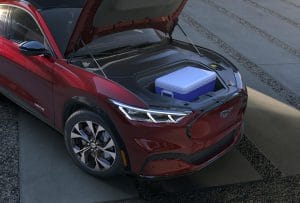It’s been nearly a decade since the Nissan Leaf became the first mainstream entry into the battery-electric vehicle market, but, with one notable exception, American motorists have yet to plug in to any significant degree. That exception is, of course, Tesla. But the upstart automaker will be facing a variety of challengers over the coming year, and the one industry observers are watching particularly closely is the all-new Ford Mustang Mach-E.
In fact, the unveiling took place at the Hawthorne Municipal Airport in California, which basically sits next to Tesla and SpaceX’s main operations. Purely a coincidence Ford officials maintain.
Ford was an earlier player in battery technology, with models like the C-Max Energi and Ford Focus EV. But the Mach-E, which Ford originally described as a “Mustang-inspired SUV,” is its first long-range model, with up to 300 miles per charge promised those purchasing its extended battery pack. But range alone isn’t enough to draw in customers, as the slow sales of Jaguar’s I-Pace have shown. Ford also is betting on the Mach-E’s performance and sleek styling to make it a serious Tesla challenger.
(Ford lets us in on a secret: It’s going to be the Mustang Mach-E)
The new SUV, which made its formal debut Sunday night during a splashy event in Los Angeles, ahead of the annual L.A. Auto Show, will be as fast as a Porsche 911 GTS, hitting 60 mph in just over three seconds, Ford announced. Meanwhile, the Mustang Mach-E will offer a variety of features likely to connect to tech-oriented millennials and other EV buyers, including a computer-sized touchscreen that will deliver real-time navigation and traffic updates and smartphone-style over-the-air updates that could be used not only to make software tweaks but also add new features and functions.
Ironically, Mach-E came about almost as an afterthought. Though Ford has sold about 800,000 “electrified” vehicles during the past decade, it has had little success with all-electric models like the Focus EV. Faced with the need to produce zero-emission vehicles that could meet strict new mandates put in place by California – and now adopted by 15 other states – the automaker decided to minimize its investment with what Kumar Galhotra, president of Ford North America, dubbed a “compliance car,” expecting little demand outside of those states.
But those plans fell apart when, in May 2017, Jim Hackett was named Ford CEO following a management shake-up. A true believer in new mobility technologies like autonomous and electrified vehicles, the former Steelcase chief executive laid out plans to invest more than $11 billion in hybrids, plug-ins and, in particular, new battery-electric vehicles that he was convinced could target a mainstream audience.
How to pull that off was the question. Part of the answer was to scrap the original SUV the automaker was developing, said Galhotra, adding that, “We knew we had to do something to stand out.”
After some brainstorming, Team Edison, Ford’s lean mobility team, decided the best approach would be to tap the familiar Mustang. While far from the automaker’s best-seller, it remains one of its most iconic brands. But it clearly wasn’t going to be easy.
“How do you create an electric Mustang SUV?” said chief exterior designer Chris Walter, during a background briefing for a handful of journalists. “That created a lot of tension in the company.”
Complicating matters, Ford management put Team Edison on an incredibly tight deadline. After nearly three years working on the original battery-SUV, they would have to start over and complete the new model in barely 24 months.
“We had no choice” but to all but completely start over – and to do it fast, relying on an assortment of new digital development tools, said Jason Castriota, Ford’s global brand director for electrification, during a background briefing at Ford’s Product Development Center in Dearborn, Michigan, earlier this month.
To get there, virtually every aspect of the vehicle had to be rejiggered. The skateboard-like platform was pulled forward 50 mm, or about two inches, the rear stretched 20 mm. On the plus side, that allowed for a sleeker design, a larger battery pack, more interior space and better vehicle dynamics, according to members of the product development team.
What was to be a front-wheel-drive powertrain was flipped around. There will now be three different powertrains for the Mustang Mach E:
- The base model using a 210 kilowatt motor on the back axle;
- The midrange model adding a 50 kW motor on the front axle to create an all-wheel-drive system; and
- The Mach-E GT will use 210 kW motors on both axles while also adding torque vectoring.
That base will deliver around 250 horsepower and over 300 pound-feet of torque, jumping to 459 hp and 612 lb-ft for the GT.
“Our base model will be faster than a base Porsche Macan (SUV) and close to the Macan Turbo,” which can hit 60 in as little as 4.1 seconds, said powertrain chief Ron Heiser. The Mach-E GT, meanwhile, “will be within spitting distance of a Porsche 911 GTS,” which sprints to 60 in a little more than three seconds.
As for its batteries, two packs will be available, the base, 75 kilowatt-hour option offering something in the mid-200 mile range, while the 98 kWh pack will push around 300 – which is in line with the expectations for what Tesla’s Model Y SUV will deliver when it comes to market next year.
(Ford teases coming Mustang-inspired SUV with video)
During a Friday background session, Ford offered a brief ride in the midrange Mach-E. Even with the smaller front motor it offered neck-snapping acceleration, one of the big pluses of using electric motors which develop maximum torque the moment they start spinning.
By mounting batteries and motors below the load floor, the Mach-E has a of gravity rivaling a conventional Mustang – something that became obvious during an aggressive slalom run. The GT, which wasn’t available for testing, should take things to another level – and not just because of its added power. Like the new Mustang Shelby GT500, the Mach-E GT will feature a Magneride suspension where a magnetorheological fluid is used to allow the vehicle’s dampers to go anywhere from full soft to rock hard in barely 1,000th of a second.
Motorists will have the option of switching between three different drive modes, including the sportiest “Unbridled.” In all but the comfort-level “Whisper” mode, the electric SUV will introduce digitally synthesized sounds matched to the vehicle’s acceleration and meant to “enhance the driving experience,” explained Heiser.
Visually, there is a clear link to the classic Mustang coupe, with its shark-like nose, long hood, sweeping roofline and sequential, triple-bar taillights. There are some key differences, starting with the fact that Mach-E is an SUV, and that means four doors – with push-buttons, rather than door handles, no less.
Walter’s design team used a clever trick to carry over a Mustang-like roof while providing more headroom, especially for rear seat passengers, with a second roofline sitting inches higher. It will be available in body color, though in black-out paint or all glass configurations, it largely vanishes.
The interior adopts a unique steering wheel atop which sits an “attention monitor” that, we’re told, will be used in the near future for a hands-free driving system. Behind the wheel, a reconfigurable gauge cluster changes colors depending on Mach-E’s driving mode.
Virtually all other displays, knobs and switches have been replaced by a portrait-oriented, 15.5-inch tocuchscreen screen running a modified version of Ford’s new Sync4 infotainment system. The Mach-E will offer a natural-speech control system and smartphone-style (and Tesla-like) over-the-air updates that will offer real-time traffic and navigation and, longer-term, will permit updating all software, including powertrain controls. That, officials noted, will allow future downloads of new features and functions, too.
Completing the interior package, Mach-E uses “vegan” materials that do an impressive imitation of traditional leather and suede.

Ford is betting Mach-E will generate far more demand than it got for “compliance cars” like the old Focus EV with its 100-mile range.
With its looks, added range and performance, Ford is betting it has addressed some of the key issues leading many potential buyers to steer clear of electric vehicles. To address another key obstacle, Mach-E adopts a 400-volt electrical architecture allowing users to go from a 10% state of charge to 80% in just 45 minutes using the newest Level 3 public quick-charging stations.
And Ford has partnered with several companies, including Electrify America and Greenlots, the latter a Shell subsidiary, to ensure access to free charging at over 12,000 stations. (It has not yet confirmed how long it will provide free energy, several competitors are doing so anywhere from one to three years.) Ford also is working with Amazon Home Services to install home chargers that can boost range by 32 miles per hour.
As for one of the biggest EV stumbling points, the company says it expects the Mustang Mach-E to be priced between $45,000 and $65,000 – before federal tax credits. And the availability of up to $7,500 per vehicle could be a critical advantage over Tesla which will see its remaining federal incentives vanish entirely on Jan. 1, 2020.
As for timing, four of the five Mach-E trim levels will launch next autumn, with the GT to follow in spring 2021. Potential customers, however, can now place an advance reservation with a $500 refundable deposit – a page Ford is lifting out of the Tesla playbook.

Much of the work on Mustang Mach-E was done at the new Ford mobility campus in Detroit’s Corktown neighborhood. Chairman Bill Ford is shown in front of the old Michigan Central Depot that will become the operation’s HQ.
But can the old Detroit automaker deliver a serious challenge to its upstart rival?
Michael Harley, executive editor of Kelley Blue Book, says Ford is making “a risky move, as slapping the badge on a futuristic, emission-free, sport-utility vehicle is about the last thing that Mustang loyalists are expecting. If the vehicle is outstanding and well-received, Ford will win big. If it falls short, the company will have another Edsel on its hands.”
After spending some time of his own in the Mach-E, Sam Abuelsamid, principal auto analyst with Navigant Research, is even more upbeat about the electric SUV’s prospects, though he thinks the SUV likely won’t generate the massive sales levels that Tesla is predicting for its Model Y – which could top 500,000 annually worldwide if CEO Elon Musk is on target.
Still, added Abuelsamid, “It will be a success for Ford and probably will be profitable,” something that would be a significant breakthrough considering even Tesla has had trouble consistently operating in the black.
(Key Details About Ford’s “Mustang-Inspired” SUV Leak Out)
As with the older Tesla Model 3, we could get a sense of how well the Ford Mustang Mach-E will fare as it starts counting up those advance orders.







Another excellent article and analysis, Mr. Eisenstein. Here, I found information–interesting information–that no other website provided on this hallmark Ford product. Thank you.
I watched the impressive and expensive live roll-out last night and was impressed by this “Mustang,” even though it’s at the other end of the E-car spectrum from the electric MINI for which I placed a deposit months ago.
The big Mustang is more visually attractive than the Tesla Model Y, and the car enjoys the much better support network that only a traditional car company can provide. Those factors give the Mustang Mach-E a fighting chance in its battle against the Model Y for the tiny slice of the market electric vehicles currently claim.
The times certainly are-a-changing: All three automobile dealerships (Ford, Chevy, and MINI) at the corner of Jackson and Wagner Roads in Ann Arbor will soon be selling all-electric vehicles. I believe the MINI will be the most fun of the three offerings, but they will all be vying for top-of-their-class status.
Thanks for the kind words, John.
Indeed, we are heading for very interesting times. I have noticed a number of folks — friends, industry analysts and potential buyers — starting to change their tune on EVs. I am more than convinced that the start of a broader acceptance curve will come from two distinct sectors: performance and luxury, where electric propulsion’s strengths lie — and where negatives, such as cost, can be minimized.
I’ll be curious to see whether the Mini SE or Mach-E prove to be the most fun to drive. I had a brief, 15-minute ride in the Ford and was duly impressed by both its handling and performance. And this was the mid-range, AWD model with the smaller front motor and lacking the GT’s Magneride suspension. I’m really looking forward to personally driving that model. Meanwhile, I agree. The Mach-E is a far more elegant and striking execution, visually, than the Model Y.
All this said, I think there will be plenty of challenges for automakers through at least mid-decade. The number of new products could carve up a small market before buyers truly plug in.
Paul E.